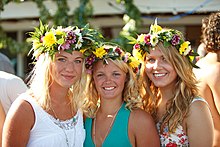Women in Sweden

Three Swedish women during the traditional Swedish celebration midsommar
|
The status and rights of Women in Sweden has been affected by culture, religion and social discourses such as by the strong feminist movement as well as laws, and changed several times through the history of Sweden.
During the Viking Age, women had a relatively free status in the Nordic countries of Sweden, Denmark and Norway, illustrated in the Icelandic Grágás and the Norwegian Frostating laws and Gulating laws. The paternal aunt, paternal niece and paternal granddaughter, referred to as odalkvinna, all had the right to inherit property from a deceased man. In the absence of male relatives, an unmarried woman with no son could further more inherit the position as head of the family from a deceased father or brother: a woman with such status was referred to as ringkvinna, and she exercised all the rights afforded to the head of a family clan, such as the right to demand and receive fines for the slaughter of a family member, until she married, by which her rights were transferred to her husband. After the age of 20, an unmarried woman, referred to as maer and mey, reached legal majority and had the right to decide of her place of residence and was regarded as her own person before the law. An exception to her independence was the right to choose a marriage partner, as marriages was normally arranged by the clan. Widows enjoyed the same independent status as unmarried women.
Women had religious authority and were active as priestesses (gydja) and oracles (sejdkvinna); they were active within art as poets (skalder) and rune masters, and as merchants and medicine women. A married woman could divorce and remarry. It was also socially acceptable for a free woman to cohabit with a man and have children with him without marrying him, even if that man was married: a woman in such a position was called frilla. There was no distinction made between children born inside or outside of marriage: both had the right to inherit property after their parents, and there was no "legitimate" or "illegitimate" children. These rights gradually disappeared from the local county laws after Christianization in the 11th century.
During the Middle Ages, the status and rights of women varied between different parts of the country, as the local county laws applied different laws in different counties. The first attempt of a national law was Magnus Erikssons landslag from 1350, which established one law for the country side, and one Stadslagen (City Law) for the city, a system which was kept by the Kristofers landslag from 1442. From 1350 onward, the civil status of women were generally the same in both the county law and the city law: an unmarried woman was under the coverture of her closest male relative, and a wife under the coverture of her husband, while a widow was of legal majority.
...
Wikipedia
